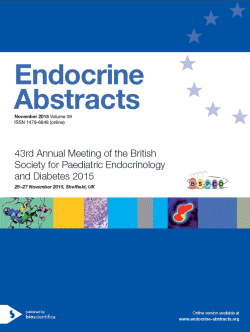
43rd Meeting of the British Society for Paediatric Endocrinology and Diabetes
e-Posters
Bone
ea0039ep13 | Bone | BSPED2015
Influence of skin colour, ethnicity, and genotype on the response to vitamin D treatment
Gopal Kothandapani Jaya Sujatha , Evans Lucy , Walsh Jennifer , Eastell Richard , Bishop Nick
ea0039ep14 | Bone | BSPED2015
Increase in lean mass may augment gains in bone mass and size in patients with osteogenesis imperfecta treated with bisphosphonates
Gopal Kothandapani Jaya Sujatha , Sritharan Shironisha , Jacques Richard , Bishop Nick , Dimitri Paul
ea0039ep15 | Bone | BSPED2015
The precision of partial image analysis of trabecular bone microarchitecture by high-resolution magnetic resonance imaging in people with childhood-onset bone abnormalities
Chen Suet Ching , Abdalrahaman Naiemh , McComb Christie , Foster John , Ahmed S Faisal
ea0039ep16 | Bone | BSPED2015
Metformin regulates the differentiation of murine mesenchymal stem cells via AMPK-independent suppression of p70s6-kinase
Chen Suet Ching , Brooks Rebecca , Ahmed S Faisal , Yarwood Stephen J
ea0039ep17 | Bone | BSPED2015
The prevalence of fragility fractures in children with cerebral palsy in Manchester: a cross-sectional survey
Patel Ekta , Alshryda Sattar , Ferguson Anne , Mughal Zulf , Padidela Raja
ea0039ep18 | Bone | BSPED2015
Trends of use of bisphosphonates in children with secondary osteoporosis
Henderson S , Alhashem G , Shaikh G , Mason A , Ahmed S F , Wong S C
ea0039ep19 | Bone | BSPED2015
Rickets due to dietary calcium deficiency in Manchester
Juma Fatema Zehra , Santos Rui , Mughal M Zulf
ea0039ep20 | Bone | BSPED2015
Early onset cataract in an infant with activating calcium-sensing receptor mutation
Ramaswamy Priya , Ryalls Mike , Allgrove Jeremy
ea0039ep21 | Bone | BSPED2015
Safe prescribing: vitamin D toxicity as a result of inadvertent overdose
Kurre Malathi , Ramaswamy Priya , Pease-Gevers Evelien , Allgrove Jeremy



